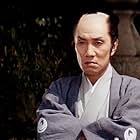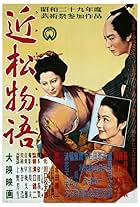IMDb RATING
7.8/10
3.9K
YOUR RATING
A kabuki theatre-inflected story about a poor village whose people have to be carried to a nearby mountain to die once they get old.A kabuki theatre-inflected story about a poor village whose people have to be carried to a nearby mountain to die once they get old.A kabuki theatre-inflected story about a poor village whose people have to be carried to a nearby mountain to die once they get old.
- Awards
- 6 wins & 1 nomination
- Director
- Writers
- All cast & crew
- Production, box office & more at IMDbPro
Storyline
Did you know
- TriviaThis was the final film to be added to Roger Ebert's list of "Great Movies" before his death on April 4, 2013 at the age of 70.
- ConnectionsFeatured in Tvennesnack: Varför kan vi inte komma ihåg den här jävla filmen? (2022)
Featured review
One of the most fascinating books I've read in recent years is Sherwin Nuland's How We Die. In it he relates the exact physical progression of major diseases. But something that fascinates me even more is how our frame of mind changes our perception. I can think of no better example in the realm of death and dying than this ancient tale of 'going up the mountain to die.' Set in an indeterminate time in old Japan, Ballad of Narayama chronicles two elderly people's preparations for death. One of them is Orin. She is a grandmother calmly facing what lies ahead, and putting her affairs (especially those of her family and how they will cope with her dying) into some sort of harmonious picture, so she doesn't have to worry about them. Her neighbour, a man of similar age, is dreading it.
We should maybe bear in mind that a strong spirit of empathy pervades Japanese society, more so than in the West. Human relations are very closely knit and there is much less drive for individualism and autonomy than in the West. Community traditions can play a very big part. And the tradition in the village where these people live is that when people reach a certain age they go up the mountain and die.
Orin takes delight in the 'glowing crimson of the autumn maple.' She has an almost non-theistic spirituality, an idealism and altruism towards others, as well as a humility about her own readiness for death. On the one hand, she says, "The sooner I go, the more the gods will favour me." But she is strangely ashamed of having a full set of teeth. She feels it would be more proper to go to her death as a toothless hag.
If you are spiritually minded, it is quite easy to say that she is in tune with her Shinto or Buddhist beliefs. But if we look at her psychology she has created a world for herself that is filled with attitudes that make her feel good about herself. The thought of her 'pilgrimage' to Narayama fills her with poetic ideas, even if she has no illusions about suffering.
The elderly man on the other hand, clings to his life. He is so obnoxious that his family react badly. They eventually refuse to feed him. "Instead of suffering so, go to Narayama," Orin bids him. "Narayama is the abode of the gods, a place of bliss and blessings." Although it is physically the same place for both of them, it is in effect a very different place for Orin because of her frame of mind. I think the lack of overt religiosity in the film emphasises this. Religion, for those that like it, simply makes, we could say, a ready made poem for us to fit into. Of course, forcing the old man up the hill is a pretty heinous act - and one that the film does not shirk from dealing with.
Often when we watch a film, we want to get submerged in the 'story.' But this can deflect from considering the point that the artist wants to make. The playwright Bertolt Brecht understood this and developed many of his influential theories after watching Japanese theatre. Borrowing from the Kabuki tradition, Ballad of Narayama distances the viewer from the story by creating a very theatrical effect. At the same time, various devices are used to make sure we remain gripped and pay attention.
The film is accompanied by expository chants of a 'jyuri' narrator. There is frequently an unashamed and flamboyant staginess. For instance, a silk backdrop is loosed to reveal a forest at night. What might be considered silly in western cinema works with a Shakespearean majesty here. The film is visually and musically arresting. It doesn't rely on 'realism' to create an effect. We start thinking about the mental states and moral dilemmas of what is patently a modern fairy tale rather than just entertainment.
At the end of the film, a sudden switch to non-theatrical black and white has a disappearing train and a station called 'The Abandoning Place.'
We should maybe bear in mind that a strong spirit of empathy pervades Japanese society, more so than in the West. Human relations are very closely knit and there is much less drive for individualism and autonomy than in the West. Community traditions can play a very big part. And the tradition in the village where these people live is that when people reach a certain age they go up the mountain and die.
Orin takes delight in the 'glowing crimson of the autumn maple.' She has an almost non-theistic spirituality, an idealism and altruism towards others, as well as a humility about her own readiness for death. On the one hand, she says, "The sooner I go, the more the gods will favour me." But she is strangely ashamed of having a full set of teeth. She feels it would be more proper to go to her death as a toothless hag.
If you are spiritually minded, it is quite easy to say that she is in tune with her Shinto or Buddhist beliefs. But if we look at her psychology she has created a world for herself that is filled with attitudes that make her feel good about herself. The thought of her 'pilgrimage' to Narayama fills her with poetic ideas, even if she has no illusions about suffering.
The elderly man on the other hand, clings to his life. He is so obnoxious that his family react badly. They eventually refuse to feed him. "Instead of suffering so, go to Narayama," Orin bids him. "Narayama is the abode of the gods, a place of bliss and blessings." Although it is physically the same place for both of them, it is in effect a very different place for Orin because of her frame of mind. I think the lack of overt religiosity in the film emphasises this. Religion, for those that like it, simply makes, we could say, a ready made poem for us to fit into. Of course, forcing the old man up the hill is a pretty heinous act - and one that the film does not shirk from dealing with.
Often when we watch a film, we want to get submerged in the 'story.' But this can deflect from considering the point that the artist wants to make. The playwright Bertolt Brecht understood this and developed many of his influential theories after watching Japanese theatre. Borrowing from the Kabuki tradition, Ballad of Narayama distances the viewer from the story by creating a very theatrical effect. At the same time, various devices are used to make sure we remain gripped and pay attention.
The film is accompanied by expository chants of a 'jyuri' narrator. There is frequently an unashamed and flamboyant staginess. For instance, a silk backdrop is loosed to reveal a forest at night. What might be considered silly in western cinema works with a Shakespearean majesty here. The film is visually and musically arresting. It doesn't rely on 'realism' to create an effect. We start thinking about the mental states and moral dilemmas of what is patently a modern fairy tale rather than just entertainment.
At the end of the film, a sudden switch to non-theatrical black and white has a disappearing train and a station called 'The Abandoning Place.'
- Chris_Docker
- Oct 8, 2007
- Permalink
- How long is The Ballad of Narayama?Powered by Alexa
Details
- Release date
- Country of origin
- Language
- Also known as
- Ballad of Narayama
- Filming locations
- Production company
- See more company credits at IMDbPro
Contribute to this page
Suggest an edit or add missing content

Top Gap
By what name was The Ballad of Narayama (1958) officially released in Canada in English?
Answer



























